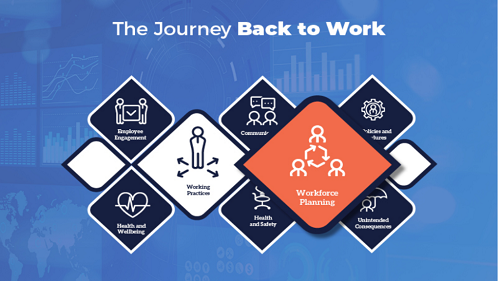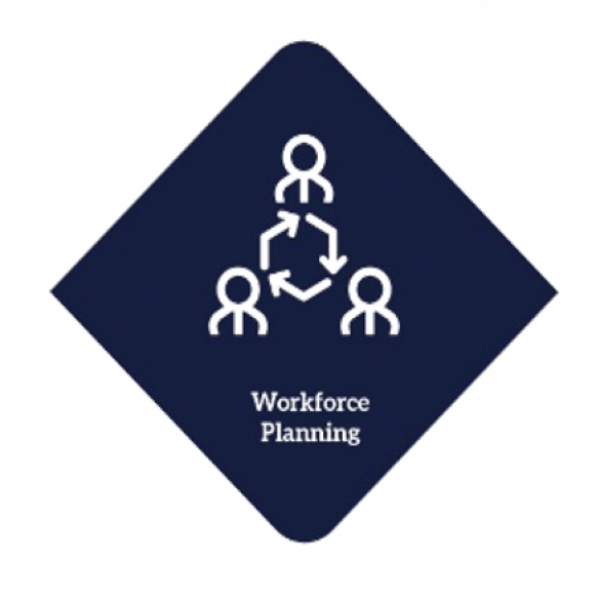The Journey Back to the Workplace: Workforce Planning

|
HR, Employment Law & Health and Safety Considerations and Planning |
Re-Organisation & Re-Structuring
When it comes to workforce planning most Organisations in the Community and Voluntary Sector previously would not have had the level of investment, either from a financial or time perspective, to conduct such an exercise. Yet workforce planning is seen by most HR professionals as a necessity, one that ensures the correct Organisational structure is in place with the required skills and experience to enable the Organisations strategy to be effectively delivered.
However, with the ongoing pandemic and the depth of the anticipated recession, now more than ever, time needs to be set aside by HR practitioners and Leaders to ensure your Organisational structure is fit for future purpose – that is to enable the delivery of your new Organisational strategy in the New Normal.
A number of streams will inevitably flow from any workforce planning context but in the current climate, the need for Organisations to reorganise or restructure is highly probable. Outlined below are the key steps and salient points to be considered when adopting a reorganisation and restructuring framework.
Benefits of Re-Organisation and Re-Structuring
The old mantra of change being the only constant has never been more true, as every Employer in the Community and Voluntary Sector now faces a challenging market in which to operate. The benefits of a reorganisation and restructuring process are threefold as it,
- Allows for a collective focus on identifying the current needs of your Organisation and the market in which you are operating.
- Identifies the specific skillset required to operate in the current climate making better use of talent.
- Rationalises efficiencies of your service offering to improve service delivery.
In order to commence any reorganisation and restructuring process Employers in the Community and Voluntary Sector must formulate a detailed understanding of the components necessary to the process with the goal being to have an Organisation and workforce with the right size, working in the right manner, at the right cost, and with the right agility.
Steps in Reorganisation and Restructuring framework
1. Planning Approach
The first step of a reorganisation and restructuring framework is to consider the approach to be taken.
In order to do this in a planned way it is essential that Employers identify the key challenges faced by the Organisation, both internally and externally, and from that, draw the essential components that will impact those areas. This means that an Employer will need to gather information on the workforce to understand what skills and experience they currently have, what challenges have presented themselves in terms of working practices and what efficiencies are to be gained.
From a financial perspective an Employer in the Community and Voluntary Sector must understand the constraints placed on funding and the impact of restrictions on fundraising revenue in the current climate. Data should also be gathered on market demographics to inform an Employer on the service offering within the Community and Voluntary Sector in order to assess what priority areas are emerging and how the needs of service users (which may be unchanged) can be serviced in a different manner in the future.
2. Environment Analysis
Once you have gathered all the essential data you must then analyse what this means for your Organisation.
An understanding of the status quo will support the identification of what direction the Organisation needs to go in order to determine newly emerged/ varied goals. This analysis drives the ‘as is’ and ‘where to’ so that you can then develop a plan to bridge the gap and resize your workforce and Organisation in a manner that aligns to the Organisational goals while still maintaining the mission and vision of the Organisation.
This action also builds the Organisational case of implementing any changes and will be driver in realising any reorganisation and restructuring process.
3. Developing an Action Plan
With the Organisational case developed HR professionals within the Community and Voluntary Sector must now determine the impact on the workforce.
Questions to ask include
- what are the skills necessary in furtherance of the Organisational objectives while still maintaining the mission and vision of the Organisation
- what efficiencies could be gained from a restructuring of the Organisations resources
- what are the necessary changes to work practices that will align your workforce to present and future needs.
From this process the potential need of new or different skillsets and / or work practices will be identified and this will determine what actions should be taken. This process can also highlight skillsets already present that may need to be further developed or re-aligned but will in their totality give an Employer good oversight on whether they are under/ over staffed and what work practices need to change.
It is at this point that HR should develop an action plan that will support the reorganisation and restructuring framework in achieving the Organisations goals. Best practice will dictate a risk register to be developed identifying any challenges that may present throughout the implementation stage of the project. As the greatest impact will be felt by your workforce it is essential that HR play a pivotal role in this process from the analysis and development right through to the implementation stage and timings thereof.
4. Implementation
At this point the Organisation and HR in particular will have a full understanding of the market conditions in which the Organisation is operating, will understand the goals of the Organisation in the current market, the Organisational case supporting those goals and will be fully informed on the skillset of staff necessary in furtherance of a reorganisation and restructure.
With a project plan developed and risks identified under a live register, implementation of plans can then commence. Effective communication is essential at the implementation stage and will support a smoother transition to any reorganisation. Any workforce might approach reorganisation and restructuring with trepidation, but transparent communications are central to implementing these changes whether it is in the creation of efficiencies, changes to work practices, upskilling your workforce or downsizing.
HR will play an integral role in onboarding the workforce to the reorganisation and restructuring framework or indeed in engaging and consulting with Unions. Compliance risk at this point will be front and centre in all negotiations and it is therefore essential that HR engage in procedurally correct practices to mitigate the risks from the employment law, employee relations and industrial relations perspective. The onboarding process taken will act as a signal to the success or failure of the implementation stage itself so HR must ensure consistency and best practice at all times.
5. Embed, Review and Realignment
To successfully embed changes to your workforce it is vital that you include a review process that will ensure the objectives are being met while still maintaining the mission and vision of the Organisation.
It can arise that certain elements of the implementation are not realised, and HR professionals will need to regularly review the actions taken in order to understand and embed the results. Where regular reviews take place, any new challenges will be identified which will in turn prompt responses that are solutions focused to continue with the embedding. The review process may also drive realignment in the achievement of working in the new normal thus creating a workforce that is resilient and flexible, working to the right size, in the right manner, at the right cost and with agility.
Disclaimer: the information in this section is provided to assist Employers on the implementation of government guidelines and must be read in that context and should not be interpreted as a legal definition of any of the information provided. The information is changing constantly, and any information relating to the government guidelines or protocols should be reviewed on the appropriate website.

For further information or advice, please contact our HR & Employment Helpdesk

Supported by Medtronic
